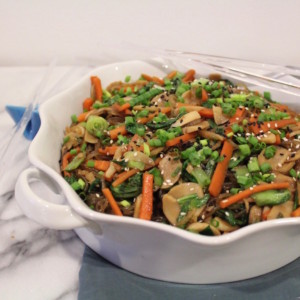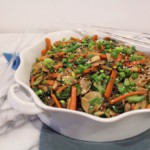Japchae is a very popular Korean dish that consists of stir fried vegetables and sweet potato glass noodles. In Korea, it is traditionally served for celebrations or to feed large groups. However, my family loves it so much we eat it usually once a week. It is relatively quick and easy to prepare. Chopping veggies is the most difficult part. You can add broccoli, asparagus, cauliflower, or any veggies you like in addition to the veggies in the recipe. Korean sweet potato noodles are gluten and lectin free. I’ve added a few ingredients to the traditional recipe to boost nutrition and have taken out a few to make sure the dish stays lectin and gluten free. If you like, you can add any fish, seafood, meat or chicken to the dish. However, it makes a great vegan/vegetarian family meal that is sure to please everyone! To learn more about Japchae, see recipe notes for the link to my blog post on the dish.
Japchae Korean Sweet Potato Glass Noodles
Japchae is a very popular Korean dish that consists of stir fried vegetables and sweet potato glass noodles. In Korea, it is traditionally served for celebrations or to feed large groups.
- Prep Time: 15
- Cook Time: 15
- Total Time: 30 minutes
- Yield: 4 1x
- Category: Dinner, Lunch, Main Dish, Side Dish
- Cuisine: Asian, Korean
Ingredients
- 250 grams Korean sweet potato glass noodles (1/2 package, available at Asian/Korean markets)
- 1 tbsp tossed sesame oil (or avocado oil)
- 4 cups spinach or kale (chopped, preferably organic)
- 2–3 cups white, shiitake or eryngii mushrooms (sliced, preferably organic)
- 3–4 tbsp fresh ginger (finely chopped, preferably organic)
- 4 cloves Garlic (finely chopped, preferably organic)
- 5–6 fresh scallions (finely chopped, green and white parts separated)
- 1 large carrot (peeled and thinly sliced, preferably organic)
- 1 small head asian cabbage or napa cabbage (chopped, optional, preferably organic)
- 1/4–1/2 cup tamari or coconut aminos (instead of soy sauce (tamari is gluten free soy sauce))
- 2 tsp toasted sesame oil (preferably organic)
- 1 tsp black sesame seeds (optional, preferably organic)
- 1 tsp white sesame seeds (optional, preferably organic )
Instructions
- Bring a large pot of water to a boil over high heat. Once the water is boiling, add 1/2 a package of the noodles to the pot or approximately 250 grams of noodles. Boil the noodles for approximately 8 minutes. Then carefully, test the noodles to see if they are tender. You want them to be al dente not mushy. Once the noodles are cooked, drain them into a large colander. Using clean kitchen scissors, cut the noodles in half or in quarters as they are very long! If you forget this step, don’t worry it is just easier to serve and eat if you remember to cut them.
- While you are waiting for the water to boil, chop the garlic, ginger, and green and white parts of the scallions and set them aside.Tip: Using the side of a metal spoon to peel ginger works very well. Drag the side of the spoon along the side of the skin of the ginger and it should peel right off.
- Chop all of the veggies, spinach or kale, mushrooms, carrots, cabbage, and any other veggies you choose to use in the dish. Set them aside.
- Set a large wok or large frying pan over medium heat. Let it warm up for a moment. Add 1 tbsp of sesame oil or avocado oil to the pan.Once the oil is hot, add the ginger, garlic, and white and light green parts of the scallions to the pan. Stir fry and keep them moving in the pan until they are translucent.
- Add the mushrooms and carrots to the pan and continue stir frying until they are tender, approximately 5 minutes. Add the spinach or kale and cabbage to the pan; continue stir frying until the greens have wilted.
- Add the tamari or the coconut aminos to the pan with the veggies and stir well.Add the noodles to the pan with the veggies and stir well until the noodles are coated with the sauce. Add the remaining sesame oil and stir well. Taste the dish to make sure it is seasoned well. You can add more tamari or coconut aminos if necessary.Sprinkle the sesame seeds over the top of the dish.
- Serve family style at the table or plate the Japchae into separate bowls or dishes. Enjoy!
Notes
For more on Japchae, see my blog post on the dish.


